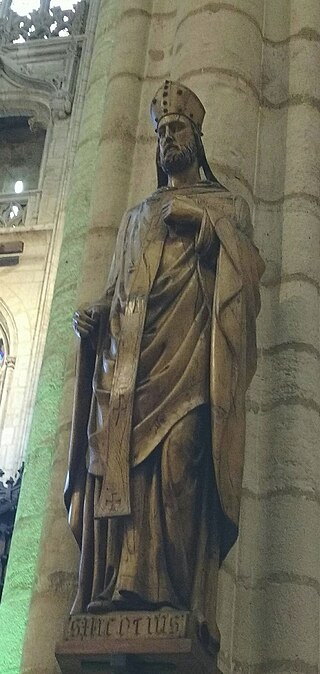Related Research Articles

Pope Sylvester I was the bishop of Rome from 31 January 314 until his death. He filled the see of Rome at an important era in the history of the Western Church, yet very little is known of him. The accounts of his pontificate preserved in the seventh- or eighth-century Liber Pontificalis contain little more than a record of the gifts said to have been conferred on the church by Constantine I, although it does say that he was the son of a Roman named Rufinus. His feast is celebrated as Saint Sylvester's Day, on 31 December in Western Christianity, and on 2 January in Eastern Christianity.
Novatian was a scholar, priest, and theologian. He is considered by the Catholic Church to have been an antipope between 251 and 258. Some Greek authors give his name as Novatus, who was an African presbyter.

Leander of Seville was the Bishop of Seville. He was instrumental in effecting the conversion of the Visigothic kings Hermengild and Reccared to Catholicism. His brother was the encyclopedist St. Isidore of Seville.
Saint Didier, also known as Desiderius, was a Merovingian-era royal official of aristocratic Gallo-Roman extraction.

Saint Exuperius was Bishop of Toulouse at the beginning of the 5th century.
Saint Aldric was Bishop of Le Mans in the time of Louis the Pious.
Anastasius I of Antioch was the Patriarch of Antioch twice.
Eustochius was the fifth bishop of Tours from 443 to 461. He was succeeded by his close relative, Saint Perpetuus. His extremely rare name suggests a possible connection to Saint Eustochium. T. S. M. Mommaerts and D. H. Kelley make the point that his father was Eustochium's brother, Julius Toxotius the Younger, and that his maternal grandfather was Publius Ceionius Caecina Albinus, of the Ceionii Volusiani.

Saint Aredius, also Yrieix, Abbé d'Attanum and Arède d'Atane, was chancellor to Theudebert I, king of Austrasia, and later Abbot of Attane. He founded the monastery of Attane, which was renamed after his death Saint-Yrieix in his honour. The town at the site became known as Saint-Yrieix-la-Perche. Several other French communes are also called Saint-Yrieix after him.

Saint Nicetius was Archbishop of Lyon, then Lugdunum, France, during the 6th century. He served from 552 or 553. He is venerated as a saint in the Catholic Church.

The Diocese of Rodez (–Vabres) is a Latin Church ecclesiastical territory or diocese of the Catholic Church in France. The episcopal see is in Rodez. The diocese corresponds exactly to the Department of Aveyron.
Eufronius or Euphronius was the eighth Bishop of Tours; he served from 555 to 573, and was a near relative of Gregory of Tours.
Caecilianus, or Caecilian, was archdeacon and then bishop of Carthage in 311 AD. His appointment as Bishop led to the Donatist Controversy of the Late Roman Empire. He was also one of only five Western bishops at the First Council of Nicea.
Saint Rusticus, the successor of Saint Lupicinus of Lyon (491-494), served as Archbishop of Lyon from 494 to April 501. Later canonized and venerated in the Catholic Church, his feast day is 25 April.
Saint Dalmatius may refer to:

Francis Patrick McFarland was an American Catholic bishop who served as the third Bishop of Hartford.

Sulpitius I was Bishop of Bourges. Often called Sulpitius Severus, the Severe, he is wrongly identified with Sulpicius Severus, the historian of Saint Martin of Tours.
Asterius of Petra was a convert from Arianism, and later the Bishop of Petra.

November 12 - Eastern Orthodox liturgical calendar - November 14
Ursicinus of Cahors or Urcis or Saint Urcsicinus was a bishop of Cahors from the early 580s until his death in around 595. His feast day is on December 13. Ursicinus was the chancellor of queen Ultragotha, wife of Childebert I, king of Paris. He was chosen by Maurilio, then-bishop of Cahors, to be his successor.
References
- ↑ "Archived copy". Archived from the original on 2012-06-25. Retrieved 2012-03-08.
{{cite web}}: CS1 maint: archived copy as title (link) - ↑ Patron Saints Index: Saint Dalmatius of Rodez Archived November 2, 2007, at the Wayback Machine
- ↑ "Dalmatius.5", The Cyclopedia of Biblical, Theological, and Ecclesiastical Literature (James Strong and John McClintock, eds.); Harper and Brothers; NY; 1880
 This article incorporates text from this source, which is in the public domain .
This article incorporates text from this source, which is in the public domain . - ↑ Jones, David Rice. "Dalmatius (6)", A Dictionary of Christian Biography, (William Smith, Henry Wace, eds.), London, John Murray, 1877, p. 782
 This article incorporates text from this source, which is in the public domain .
This article incorporates text from this source, which is in the public domain . - ↑ Electronic Antiquities Volume III, Number 3
- ↑ Odden, Per Einer. "Den hellige Dalmatius av Rodez (d. 580)", Den katolske kirke